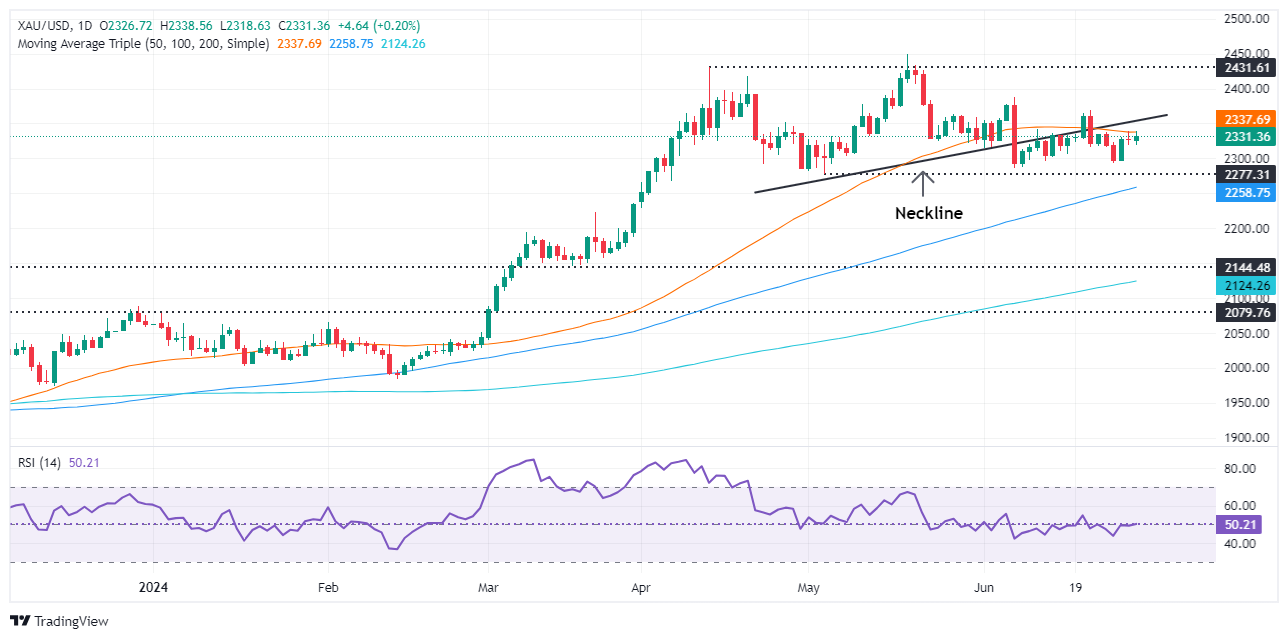- Gold remains steady, unaffected by rising US Dollar and Treasury yields.
- Mixed US manufacturing data: S&P PMI expands, ISM PMI contracts for third consecutive month.
- US 10-year Treasury yield climbs nearly 9 bps to 4.489%, bolstering Greenback rebound.
Gold price advances late on Monday even though the Greenback registers minuscule gains propelled by elevated US Treasury bond yields, following a release of softer-than-expected US economic data. That, along with a shortened week in observance of Independence Day in the US and an eventful week, keeps the XAU/USD trading within familiar levels near $2,331, up 0.23%.
The US economy revealed business activity figures on the manufacturing front with mixed readings. The S&P Global Manufacturing PMI stood in expansionary territory, contrary to the ISM one, which contracted for the third straight month in June.
Market participants remained cautious, with US equity indices performing mixed in the mid-North American session. Meanwhile, the US 10-year Treasury yield rose almost nine basis points to 4.489%, lending a lifeline to the Greenback, down 0.33% earlier in the day before staging a comeback, gaining 0.09%.
Traders are eyeing the Federal Reserve (Fed) Chairman Jerome Powell's speech on Tuesday, followed by the Fed’s latest monetary policy minutes on Wednesday. After that, the US economic schedule will feature Services PMIs from S&P and the ISM, followed by Friday’s US Nonfarm Payrolls.
Daily digest market movers: Gold price prints minimal gains post-PMIs
- June’s US S&P Global Manufacturing PMI was 51.6, slightly higher than the previous month but missing the forecast of 51.7.
- ISM Manufacturing PMI for June was 48.5, lower than the estimates of 49.1 and down from May’s 48.7.
- According to CME FedWatch Tool, odds for a 25-basis-point Fed rate cut in September are at 59.5%, up from 58.2% last Friday.
- December 2024 fed funds rate futures contract implies that the Fed will ease policy by just 35 basis points (bps) by end of year.
Technical analysis: Gold price hovers around Head-and-Shoulders neckline
Gold price remains upwardly biased, though it is consolidating near the Head-and-Shoulders neckline from $2,320 to $2,350. Although the bearish chart pattern remains in play, momentum has shifted neutral, with the Relative Strength Index (RSI) braced to its 50-neutral line, hinting that neither buyers nor sellers are in control.
For a bearish continuation, sellers need to push prices below $2,300. Once done, the next support would be the May 3 low of $2,277, followed by the March 21 high of $2,222. Further losses lie underneath, with sellers eyeing the Head-and-Shoulders chart pattern objective from $2,170 to $2,160.
On the other hand, if buyers stepped in and conquered $2,350, that would expose additional key resistance levels like the June 7 cycle high of $2,387, ahead of challenging the $2,400 figure.
Gold FAQs
Gold has played a key role in human’s history as it has been widely used as a store of value and medium of exchange. Currently, apart from its shine and usage for jewelry, the precious metal is widely seen as a safe-haven asset, meaning that it is considered a good investment during turbulent times. Gold is also widely seen as a hedge against inflation and against depreciating currencies as it doesn’t rely on any specific issuer or government.
Central banks are the biggest Gold holders. In their aim to support their currencies in turbulent times, central banks tend to diversify their reserves and buy Gold to improve the perceived strength of the economy and the currency. High Gold reserves can be a source of trust for a country’s solvency. Central banks added 1,136 tonnes of Gold worth around $70 billion to their reserves in 2022, according to data from the World Gold Council. This is the highest yearly purchase since records began. Central banks from emerging economies such as China, India and Turkey are quickly increasing their Gold reserves.
Gold has an inverse correlation with the US Dollar and US Treasuries, which are both major reserve and safe-haven assets. When the Dollar depreciates, Gold tends to rise, enabling investors and central banks to diversify their assets in turbulent times. Gold is also inversely correlated with risk assets. A rally in the stock market tends to weaken Gold price, while sell-offs in riskier markets tend to favor the precious metal.
The price can move due to a wide range of factors. Geopolitical instability or fears of a deep recession can quickly make Gold price escalate due to its safe-haven status. As a yield-less asset, Gold tends to rise with lower interest rates, while higher cost of money usually weighs down on the yellow metal. Still, most moves depend on how the US Dollar (USD) behaves as the asset is priced in dollars (XAU/USD). A strong Dollar tends to keep the price of Gold controlled, whereas a weaker Dollar is likely to push Gold prices up.
Information on these pages contains forward-looking statements that involve risks and uncertainties. Markets and instruments profiled on this page are for informational purposes only and should not in any way come across as a recommendation to buy or sell in these assets. You should do your own thorough research before making any investment decisions. FXStreet does not in any way guarantee that this information is free from mistakes, errors, or material misstatements. It also does not guarantee that this information is of a timely nature. Investing in Open Markets involves a great deal of risk, including the loss of all or a portion of your investment, as well as emotional distress. All risks, losses and costs associated with investing, including total loss of principal, are your responsibility. The views and opinions expressed in this article are those of the authors and do not necessarily reflect the official policy or position of FXStreet nor its advertisers. The author will not be held responsible for information that is found at the end of links posted on this page.
If not otherwise explicitly mentioned in the body of the article, at the time of writing, the author has no position in any stock mentioned in this article and no business relationship with any company mentioned. The author has not received compensation for writing this article, other than from FXStreet.
FXStreet and the author do not provide personalized recommendations. The author makes no representations as to the accuracy, completeness, or suitability of this information. FXStreet and the author will not be liable for any errors, omissions or any losses, injuries or damages arising from this information and its display or use. Errors and omissions excepted.
The author and FXStreet are not registered investment advisors and nothing in this article is intended to be investment advice.
Recommended content
Editors’ Picks

EUR/USD retests daily lows near 1.0850 on softer US PPI
EUR/USD remains on the defensive against the backdrop of another positive day in the US Dollar, always amid intense tariff jitters and weaker-than-expected US Producer Prices in February.

Gold extends weekly uptrend, closes in on $2,950
Gold continues to push higher toward $2,950 after closing the previous two days in positive territory. The precious metal benefits from the risk-averse market atmosphere as investors grow increasingly concerned about trade wars causing an economic downturn.

GBP/USD stay defensive near 1.2950 as risk-off mood persists
GBP/USD is on the defensive near 1.2950 in the European session on Thursday. The pair faces headwinds from intensifying tariff war globally and a pause in the US Dollar downtrend. Traders look forward to the US PPI data for fresh directional impetus.

Metaverse narrative stalls as price action fades, but on-chain data signals continuing accumulation
Metaverse tokens are cryptocurrencies associated with virtual worlds, digital economies, and immersive online experiences. Tokens like Sandbox, Decentraland, and Axie Infinity, three of the most prominent assets during the Metaverse boom of 2021, continue to face correction since they topped in early December.

Brexit revisited: Why closer UK-EU ties won’t lessen Britain’s squeezed public finances
The UK government desperately needs higher economic growth as it grapples with spending cuts and potential tax rises later this year. A reset of UK-EU economic ties would help, and sweeping changes are becoming more likely.

The Best brokers to trade EUR/USD
SPONSORED Discover the top brokers for trading EUR/USD in 2025. Our list features brokers with competitive spreads, fast execution, and powerful platforms. Whether you're a beginner or an expert, find the right partner to navigate the dynamic Forex market.
